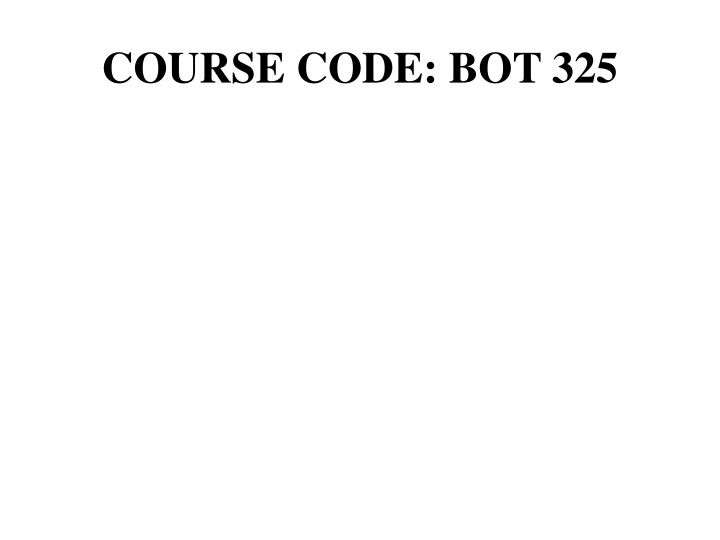
Exploring the Fascinating World of Fungi in Botany and Mycology
Delve into the intriguing realm of fungal biology with Course Code BOT 325. This course covers genetic and biochemical properties of fungi, their taxonomy, and their diverse roles in human health and agriculture. Discover the close relationship between mycology and phytopathology, explore the Kingdom Fungi, and learn about fungi as food sources, pests, and disease agents. Gain insights into fungal nutrition, reproduction, and environmental roles, highlighting the vital importance of fungi in the ecosystem.
Download Presentation

Please find below an Image/Link to download the presentation.
The content on the website is provided AS IS for your information and personal use only. It may not be sold, licensed, or shared on other websites without obtaining consent from the author. If you encounter any issues during the download, it is possible that the publisher has removed the file from their server.
You are allowed to download the files provided on this website for personal or commercial use, subject to the condition that they are used lawfully. All files are the property of their respective owners.
The content on the website is provided AS IS for your information and personal use only. It may not be sold, licensed, or shared on other websites without obtaining consent from the author.
E N D
Presentation Transcript
COURSE DESCRIPTION: PLANT MYCOLOGY
COURSE LECTURER: DR.(MRS.) KEHINDE, I. A.
genetic and biochemical properties, their taxonomy and their use to humans as sources for medicinals and food, as well as their dangers, such as poisoning or infection.
Mycology is closely related to phytopathology: the study of plant diseases.
whole kingdom all to themselves-- Kingdom Fungi. Classification of mushrooms, molds and yeasts is based on reproductive structures.
important as a food source, as destructive pests, and as agents of disease. The study of fungi continues to produce important advancements in science. A Fungus
hyphae, or by budding (4) obtain nutrients by releasing digestive enzymes into the environment to break down organic molecules, which are then absorbed and (5) have no chlorophyll.
Fungi do not ingest their food (by eating). They have a filamentous or budding growth habit, along with the presence of cells walls
Most fungi reproduce through the generation of spores. Fungal spores are non-motile (meaning they cannot move of their own accord).
role in the environment by decomposing and recycling organic matter. A few are parasitic on plants causing major losses of crops while others cause various infections on humans or other animals. The Structure of Fungi
fungi is the hypha (pl hyphae), which is thin and tubular in shape.A network arrangement of hyphae is referred to as mycelium
Not all fungi have hyphae. Yeasts are essentially unicellular, producing round or oblong cells that bud from a mother cell to produce daughter cells.
Spores are specialized for dispersal and survival. Though produced in large numbers only few find their way to plants to cause infection.
Spores can be produced asexually via mitosis, in which case they are called conidia. Spores may also be produced sexually. Fungal Classification
Zygomycota and Dueteromycota. However, the Oomycota (water molds) are considered by some to be fungal protists because they have a motile phase. Fungal classification is based on the morphology of sexually produced spores.
numerous conidia or reproduce sexually to form microscopic zygospores. Black bread mold is a zygomycete.
conidia as well as larger fruit bodies that contain sexually derived ascospores inside a cell type called the ascus.
sexually produced basidiospores that form at the ends of cells called basidia. Examples Agaricus bisporus, Pleurotus subnudus, Termitomyces sp.
Some fungi have no known sexual phase and these are put in the Deuteromycota. These kinds of fungi are commonly called molds.
